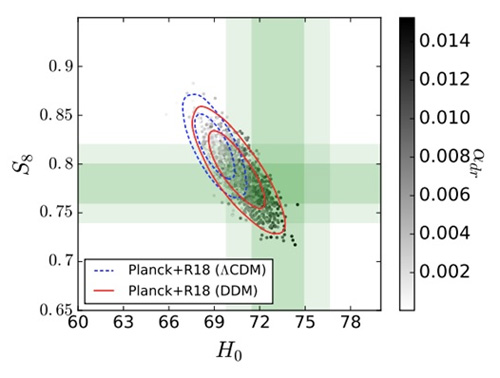 The measurement of the expansion rate of our universe currently is one of the key things in cosmology, enabling us to know about the evolution of the universe over billions of years and also about the fundamental components of universe like visible and dark matter and dark energy. Hubble parameter is the constant used to describe the expansion of the universe. There are many experiments which measure present-day Hubble parameter H0; most of them are from direct measurements of local universe observables, which involve supernovae, Cepheids, Red giants, etc. But, Cosmic Microwave Background (CMB) Planck experiments also can measure H0 with very high precision, as the travel path of CMB photon, which is reaching us from last scattering surface, also depends on present expansion rate.
The measurement of the expansion rate of our universe currently is one of the key things in cosmology, enabling us to know about the evolution of the universe over billions of years and also about the fundamental components of universe like visible and dark matter and dark energy. Hubble parameter is the constant used to describe the expansion of the universe. There are many experiments which measure present-day Hubble parameter H0; most of them are from direct measurements of local universe observables, which involve supernovae, Cepheids, Red giants, etc. But, Cosmic Microwave Background (CMB) Planck experiments also can measure H0 with very high precision, as the travel path of CMB photon, which is reaching us from last scattering surface, also depends on present expansion rate.One of the recent as well as a serious challenge in cosmology is the Planck measured value of H0 is 4 sigma lower than its value from local measurements of Hubble parameter. If this problem persists, it challenges our understanding of cosmology with well-accepted ΛCDM (cosmological constant as dark energy and cold dark matter) model. The Hubble anomaly points to physics beyond our current understanding.
A researcher from the Indian Institute of Astrophysics (IIA) an autonomous institute of Department of Science & Technology, Government of India has shown that a much deeper dark sector physics where a fraction of dark matter is allowed to disappear into photon like a particle in the dark sector can automatically solve Hubble anomaly. This tiny disappearance of energy in the form of dark radiation is allowed by CMB Planck experiments data as this photon like particle belongs to the dark sector and does not interact with the visible sector. But it affects the expansion rate in a way to resolve the Hubble anomaly.
The results of recent work of Prof. Subinoy Das from IIA in collaboration with researchers from Johns Hopkins University and International Centre for Theoretical Sciences (ICTS) Bangalore has been accepted for publication in reputed cosmology journal JCAP ( Journal of cosmology and astroparticle physics) with the title “Alleviating the H0 and σ8 anomalies with a decaying dark matter model”.
In collaboration with Dr Tanvi Karwal from Johns Hopkins University and Dr Kanhaiya Pandey from IIA and ICTS, Bangalore, Prof. Das from IIA has run statistical simulations with Planck and local universe H0 data incorporating the secret dark matter decay scenario and shown that the H0 value inferred from the simulation seems to resolve the discrepancy to a great extent. This is a promising result as this not only give first of a kind solution to this anomaly involving richer dark sector but also seems to reduce other problem ( called S8 anomaly) in Planck and weak lensing data.
For The green band In the figure is the preferred H0 value from local universe, as one can see, red contour (dark matter decay DDM model) moves towards green band as compared with blue contour (standard cosmology model).
For further details, Dr Subinoy Das (subinoy[at]iiap[dot]res[dot]in) can be contacted.






























